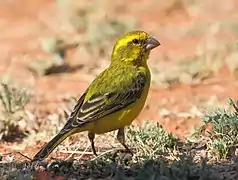Yellow canary
The yellow canary (Crithagra flaviventris) is a small passerine bird in the finch family. It is a resident breeder in much of the western and central regions of southern Africa and has been introduced to Ascension and St Helena islands.
| Yellow canary | |
|---|---|
 | |
| In Northern Cape, South Africa | |
| Scientific classification | |
| Domain: | Eukaryota |
| Kingdom: | Animalia |
| Phylum: | Chordata |
| Clade: | Dinosauria |
| Class: | Aves |
| Order: | Passeriformes |
| Family: | Fringillidae |
| Subfamily: | Carduelinae |
| Genus: | Crithagra |
| Species: | C. flaviventris |
| Binomial name | |
| Crithagra flaviventris (Gmelin, JF, 1789) | |
| Synonyms | |
|
Serinus flaviventris | |
Taxonomy
The yellow canary was formally described in 1789 by the German naturalist Johann Friedrich Gmelin in his revised and expanded edition of Carl Linnaeus's Systema Naturae. He placed it with the crossbills in the genus Loxia and coined the binomial name Loxia flaviventris. He specified the location as the Cape of Good Hope.[2][3] The specific epithet flaviventris is from Latin flavus meaning "yellow" and venter, ventris meaning "belly".[4] Gmelin based his account on the "Le Gros-bec jaune du Cap de Bonne Espérance" that had been described and illustrated in 1760 by the French zoologist Mathurin Jacques Brisson.[5]
The yellow canary was formerly placed in the genus Serinus but a phylogenetic study published in 2012 found that the genus was polyphyletic.[6] In the reorganisation to create monophyletic genera, Serinus was split and a number of species including the yellow canary were moved to the resurrected genus Crithagra that had originally been introduced in 1827 by the English ornithologist William Swainson.[7][8]
Four subspecies are recognised:[7]
- C. f. damarensis (Roberts, 1922) – southwest Angola, Namibia, Botswana and central north South Africa
- C. f. flaviventris (Gmelin, JF, 1789) – extreme south Namibia and west, southwest South Africa
- C. f. guillarmodi (Roberts, 1936) – highlands of Lesotho
- C. f. marshalli (Shelley, 1902) – southeast Botswana, central, northeast South Africa and lowlands of Lesotho
Description

The yellow canary is typically 10 cm in length. The adult male colour ranges from almost uniform yellow in the northwest of its range to streaked, olive backed birds in the southeast. The underparts, rump and tail sides are yellow. The female has grey-brown upperparts, black wings with yellow flight feathers, and a pale supercilium. The underparts are white with brown streaking. The juvenile resembles the female, but has heavier streaking.
This species is easily distinguished from the yellow-fronted canary by its lack of black facial markings, and its bill is less heavy than that of other similar African Crithagra species.
The brimstone canary, with overlapping range, is a known confusion species.
Distribution and habitat
Its habitat is karoo and coastal or mountain valley scrub. It builds a compact cup nest in a scrub.
The yellow canary is a common and gregarious seedeater. Its call is chissick or cheree, and the song is a warbled zee-zeree-chereeo.
References
- BirdLife International (2018). "Crithagra flaviventris". IUCN Red List of Threatened Species. 2018: e.T22720201A131999475. doi:10.2305/IUCN.UK.2018-2.RLTS.T22720201A131999475.en. Retrieved 12 November 2021.
- Gmelin, Johann Friedrich (1789). Systema naturae per regna tria naturae : secundum classes, ordines, genera, species, cum characteribus, differentiis, synonymis, locis (in Latin). Vol. 1, Part 2 (13th ed.). Lipsiae [Leipzig]: Georg. Emanuel. Beer. p. 856.
- Dickinson, E.C.; Christidis, L., eds. (2014). The Howard & Moore Complete Checklist of the Birds of the World. Vol. 2: Passerines (4th ed.). Eastbourne, UK: Aves Press. p. 330. ISBN 978-0-9568611-2-2.
- Jobling, James A. (2010). The Helm Dictionary of Scientific Bird Names. London: Christopher Helm. p. 161. ISBN 978-1-4081-2501-4.
- Brisson, Mathurin Jacques (1760). Ornithologie, ou, Méthode Contenant la Division des Oiseaux en Ordres, Sections, Genres, Especes & leurs Variétés (in French and Latin). Vol. 3. Paris: Jean-Baptiste Bauche. pp. 227-229 No. 3, Plate 11 Fig. 2. The two stars (**) at the start of the section indicates that Brisson based his description on the examination of a specimen.
- Zuccon, Dario; Prŷs-Jones, Robert; Rasmussen, Pamela C.; Ericson, Per G.P. (2012). "The phylogenetic relationships and generic limits of finches (Fringillidae)" (PDF). Molecular Phylogenetics and Evolution. 62 (2): 581–596. doi:10.1016/j.ympev.2011.10.002. PMID 22023825.
- Gill, Frank; Donsker, David; Rasmussen, Pamela, eds. (July 2023). "Finches, euphonias". IOC World Bird List Version 13.2. International Ornithologists' Union. Retrieved 23 August 2023.
- Swainson, William (1827). "On several forms in ornithology not hitherto defined". Zoological Journal. 3: 348.
External links
- Yellow canary- Species text in The Atlas of Southern African Birds.
